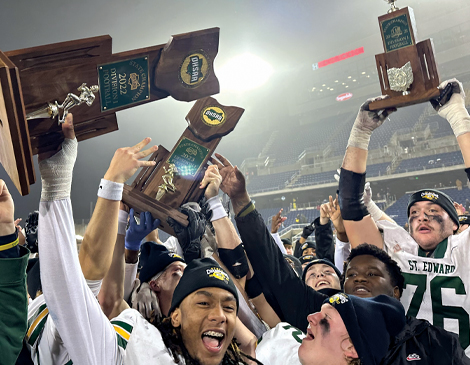Former Lakewood High School Principal Mark Walter can be forgiven for not always remembering how to say, “Good morning,” at the beginning of a school day in all the native languages spoken by the students. At one point in Walter’s career as the school’s top administrator, pupils spoke a total of 36 languages and dialects. Walter acknowledges that Google Translate was a big help.
Walter is now director of community and district activities for Lakewood City Schools. (Administrator Joy Morgan assumed the principal’s position Aug. 1.) The new post reflects a rare city government/school relationship. Walter thinks just two other school districts in Ohio have schools with jurisdiction over the municipal recreation offerings. The paradigm provides more coordination with academics, scholastic athletics and community programming, he says. It especially makes sense for Lakewood, a city with very diverse general and school populations. The approximately 1,300 Lakewood High School students represent countries from North America, Latin America, South America, Eastern Europe, Asia and the Middle East.
“It’s absolutely fabulous,’’ says Walter, Lakewood High Class of 1982. “Our kids bring so much to the culture of our schools, and we learn as much from them as they learn from us. I feel like it’s the United Nations. We have highly inclusive schools, and the kids get along really well with each other.”
That success does not happen by itself. It requires effort. Language hurdles can be difficult, particularly for some global students who did not study English in their native countries. But Walter says the high school’s extensive experience with immigrants and refugees means it “is pretty good at this point” at providing students with language barriers — and their parents — the help they need.
Being made to feel included, and to thrive, involves more than language skills. Lakewood High School, with its minority enrollment of 26 percent, features one of the broadest curricula in the state. Courses are geared toward preparing students for college, a career immediately after high school or the military. Some of the newest include Diversity in Literature, Black History Studies and Native American Studies.
Long known for its superior performing arts, Lakewood High School also attracts students from every culture to its choir, band and orchestra. (After all, didn’t someone once say that music is the only true universal language?) This past spring, band members performed music with Caribbean and Latin American themes.
“It was outstanding,” Walter says. “You heard music you don’t typically hear in a high school band concert. You were dancing in your seat.”
Athletics are another important way to build participation and school community. Lakewood High School recognizes more than just elite athletes. Last year, the school hosted a Special Olympics Unified Champions event and invited students from other districts to join.
“A typical student partnered with a special-needs student to compete in the events,’’ Walter says. “The student body came out to cheer the athletes, and we had cheerleaders and the band involved. It was a super-nice event.”
Walter also highlighted the Sparkle Squad, comprised of students with special needs who cheer alongside other cheerleaders. Clubs, including Girls Leadership Group and The LHS History Club (where students share their different cultures with each other), offer other ways to join the school community.
“Our students know that people with different religions, skin color or special needs are just people,” Walter says. “The fear of the unknown causes a lot of problems in a society. When our kids leave us, they know those differences — and similarities — are commonplace. It breaks down barriers for them if they see someone in a wheelchair or wearing a hijab.”




